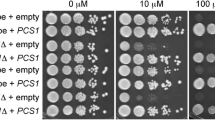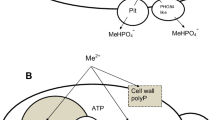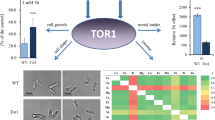Abstract
In fungi, cellular resistance to heavy metal cytotoxicity is mediated either by binding of metal ions to proteins of the metallothionein type or by chelation to phytochelatin-peptides of the general formula (γ-Glu-Cys)n-Gly. Hitherto, only one fungus, Candida glabrata has been shown to contain both metal inactivating systems. Here we show by unambiguous FAB-MS analysis that both a metallothionein-free mutant of Saccharomyces cerevisiae as well as a wildtype strain synthesize phytochelatin (PC2) upon exposure to 250 μM Cd2+ ions. The presence of Zn and/or Cu ions in the nutrient broth also induces PC2 synthesis in this organism. By 109Cd exchange and subsequent monobromobimane fluorescence HPLC, it could be shown that the presence of Cd2+ in the growth medium also induces phytochelatin synthesis in Neurospora crassa, which contains metallothioneins.
Similar content being viewed by others
References
Axen R, Drevin H, Carlsson J (1975) Preparation of modified agarose gels containing thiol groups. Acta Chem Scand [B] 29: 471–474
Butt SR, Ecker DJ (1987) Yeast metallothionein and applications in biotechnology. Microbiol Rev 51: 351–364
Fahey RC, Newton GL, Dorian R, Kosower EM (1981) Analysis of biological thiols: quantitative determination of thiols at the picomole level based upon derivatization with monobromobimanes and separation by cation-exchange chromatography. Anal Biochem 111: 357–365
Fogel S, Welch JW (1982) Tandem gene amplification mediates copper resistance in yeast. Proc Natl Acad Sci USA 79: 5342–5346
Gekeler W, Grill E, Winnacker E-L, Zenk MH (1989) Survey of the plant kingdom for the ability to bind heavy metals through phytochelatins. Z Naturforsch 44c: 361–369
Grill E, Löffler S, Winnacker E-L, Zenk MH (1989) Phytochelatins, the heavy-metal binding peptides of plants, are synthesized from glutathione by a specific γ-glutamylcysteine dipeptidyl transpeptidase (phytochelatin synthase). Proc Natl Acad Sci USA 86: 6838–6842
Grill E, Thumann J, Winnacker E-L, Zenk MH (1988) Induction of heavy metal-binding phytochelatins by inoculation of cell cultures in standard media. Plant Cell Rep 7: 375–378
Grill E, Winnacker E-L, Zenk MH (1985) Phytochelatins: the principal heavy-metal complexing petides of higher plants. Science 230: 674–676
Grill E, Winnacker E-L, Zenk MH (1986) Synthesis of seven different homologous phytochelatins in metal exposed Schizosac-charomyces pombe cells. FEBS-Lett 197: 115–120
Grill E, Zenk MH (1989) Wie schützen sich Pflanzen vor toxischen Schwermetallen? Chemie in unserer Zeit 23: 193–199
Hamer DH, Thiele DJ, Lemontt JE (1985) Functional autoregulation of yeast copperthionein. Science 228: 685–690
Isobe M, Uyakul D, Liu K, Goto T (1990) FAB-MS/MS spectrometry in determining the primary structure of γ-glutamyl-containing peptides. Agric Biol Chem 54: 1651–1660
Joho M, Imai M, Murayama T (1985) Different distribution of Cd2+ between Cd-sensitive and Cd-resistant strains of Saccharomyces cerevisiae. J Gen Microbiol 131: 53–56
Kägi JHR, Nordberg M (1979) Metallothionein. Experientia 34. Suppl Birkhäuser, Basel Boston Stuttgart
Kondo N, Isobe M, Imai K, Goto T (1984) Cadystin A and B, major unit peptides comprising cadmium binding peptides induced in a fission yeast. Tetrahedron Lett 25: 3869–3872
Kon-Ya Y, Yoshimura E, Yamazaki S, Toda S (1990) Identification of Cd-binding peptides of fission yeast Schizosaccharomyces pombe by FRIT-FAB LC/MS. Agric Biol Chem 54: 3327–3329
Lerch K (1980) Copper metallothionein, a copper-binding protein from Neurospora crassa. Nature 284: 368–370
Mehra RK, Tabet EB, Gray WR, Winge DR (1988) Metal-specific synthesis of two metallothioneins and γ-glutamyl peptides in Candida glabrata. Proc Natl Acad Sci USA 85: 8815–8819
Mortimer RK, Schild D, Contopoulou CR, Kans JA (1989) Genetic map of Saccharomyces cerevisiae, edn 10. Yeast 5: 321–403
Newton G, Dorian R, Fahey RC (1981) Analysis of biological thiols: derivatisation with monobromobimane and separation by reversed-phase HPLC. Anal Biochem 114: 383–387
Phares EF (1971) Large scale growth of bacteria. Methods Enzymol 22: 441–476
Rauser WE (1990) Phytochelatins, Annu Rev Biochem 59: 61–86
Roepstorf P, Fohlman J (1984) Proposal for a common nomenclature for sequence ions in mass spectra of peptides. Biomed Mass Spectr 11: 601
Russel P, Nurse P (1986) Cd2+ functions as an inducer in the mitotic control of fission yeast. Cell 45: 145–153
Sherman F, Fink GR, Hicks JB (1986) Methods in yeart genetics, Cold Spring Harbor Press, Cold Spring Harbor, New York, p 165
Steffens JC (1990) The heavy metal-binding peptides of plants. Ann Rev Plant Physiol Mol Biol 41: 553–575
Steffens JC, Hunt DF, Williams BG (1986) Accumulation of nonprotein metal-binding polypeptides (γ-glutamyl-cysteinyl)n-glycine in selected cadmium resistant tomato cells. J Biol Chem 261: 13879–13882
Strasdeit H, Duhme A-K, Kneer R, Zenk MH, Hermes C, Nolting H-F (1991) Evidence for discrete Cd(SCys)4 units in cadmium phytochelatin complexes from EXAFS spectroscopy. J Chem Soc Chem Commun 16: 1129–1130
Tohoyama H, Inouhe M, Joho M, Murayama T (1990) Resistance to cadmium is under the control of the CAD2 gene in the yeast Saccharomyces cerevisiae. Curr Genet 18: 181–185
Vogel HJ (1956) A convenient growth medium for Neurospora (medium N). Microbial Gen Bull 13: 42–43
Author information
Authors and Affiliations
Rights and permissions
About this article
Cite this article
Kneer, R., Kutchan, T.M., Hochberger, A. et al. Saccharomyces cerevisiae and Neurospora crassa contain heavy metal sequestering phytochelatin. Arch. Microbiol. 157, 305–310 (1992). https://doi.org/10.1007/BF00248673
Received:
Accepted:
Issue Date:
DOI: https://doi.org/10.1007/BF00248673




